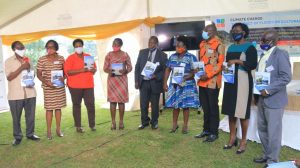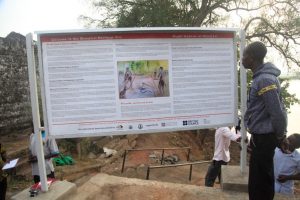On the 23rd of February, CCFU convened national stakeholders such as civil society organisations, government departments, ministries and agencies, private sector, cultural institutions and representatives from the British Council in Uganda to share experiences on the impact of climate change on cultural heritage sites and natural flood management in the Rwenzori and Alur regions.
Discussions were joined by CCFU’s partner the International National Trusts Organisation and its members from the United Kingdom. Mr. Makame Juma from the Zanzibar Stone Town Heritage Society also shared experiences to foster knowledge exchange on Natural Flood Management Systems.
Two booklets highlighting the impact of climate change on cultural heritage sites in the Rwenzori and Alur regions were launched.

The impact of climate change on Uganda’s cultural heritage
The receding snow on the Rwenzori mountains coupled with the persisting presence of the rainfall belt over the East Africa region associated with prevailing high-pressure over the Indian Ocean and influx of moisture-laden winds from the Atlantic Ocean and the Congo Forests has resulted in the flooding of rivers such as Nyamwamba, Mobuku, Lhuburiba, Nyamugasani and Sebwe) whose banks burst affecting cultural heritage sites in Rwenzori region.


A recent study as well reveals that water levels in Lake Victoria, which is the main source of water for River Nile, has overtaken its normal long-term average and will continue to rise for the next ten years. This has left the area around Packwach bridge flooding, posing a risk on the Wang-Lei cultural heritage site, a place where Gipir (Nyipiri) and Labong (Nyabongo), Luo descents separated.
Key interventions
The Cross-Cultural Foundation of Uganda (CCFU), in partnership with the International National Trusts Organisation (INTO) has been implementing a project titled “Melting snow and rivers in flood; mitigating the impact of a warming climate on Uganda’s heritage”. The five and a half-months project funded by the British Council’s Cultural Protection Fund (CPF) aimed at contributing to the preservation of important elements of the cultural heritage of the Bakonzo in the Rwenzori region and the Alur in West Nile.
The project documented the threatened cultural heritage, including at least 30 intangible cultural heritage expressions of the Alur (related with Wang-Lei) and the Bakonzo –with mapping and marking nine threatened Bakonzo heritage sites. Other interventions include a 40m-gabion cage retaining wall and an information board erected at Wang-Lei.


CCFU supported the development of heritage sites management plans and built the capacity of site caretakers and owners in both regions to manage the sites. Signposts to guide tourists and visitors to the sites at Wang-Lei and in the Rwenzori region were erected.
CCFU’s previous work with other cultural heritage sites in Uganda
To strengthen efforts towards the conservation, protection and safeguarding of Uganda’s heritage, CCFU has also documented historical buildings, sites and monuments that are under threat in the cities of Kampala, Entebbe, Jinja and Fort Portal and developed a map and an app that tells their history and significance. The Foundation is also involved in harnessing cultural resources to promote conservation of the chimpanzee in Rwenzori and Bunyoro sub regions.

